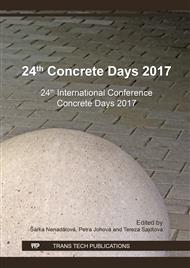p.209
p.214
p.220
p.226
p.232
p.238
p.244
p.250
p.256
Bond Behaviour between GFRP Reinforcement and Concrete Using a Pull-Out Test
Abstract:
Corrosion of steel reinforcement is one of the most often deterioration reasons of RC structures. At present, the corrosion of steel reinforcement can be avoided by using non-metallic reinforcement from composite materials, especially in structures that are exposed to extreme environmental environment. These materials are durable and non-conductive. They are composited from two materials: fibres and matrix. The most commonly used FRP (Fiber Reinforced Polymers - FRP) reinforcement are glass fibre reinforced polymers (GFRP). The bar surface can be e.g. sanded, wrapped, with helically wound ribs. The bond between concrete and reinforcement is one of the basic requirements for the composite action of both materials. The transfer of forces between the steel reinforcement and the concrete is provided by the following mechanisms: adhesion, friction and mechanical interlocking. The bond between GFRP reinforcement and concrete is different and it is ensured by friction and mechanical interlocking of the rebar surface. The chemical bond does not originate between GFRP reinforcement and the surrounding concrete, so adhesion does not contribute to transfer of the bond forces. Some few test methods are used to determine the bond between GFRP reinforcement and concrete. The pull-out test were used to determine the bond behaviour between GFRP rebars and concrete. This paper describes the preparation, process, results and evaluation of the pull-out tests.
Info:
Periodical:
Pages:
232-237
Citation:
Online since:
February 2018
Authors:
Keywords:
Price:
Сopyright:
© 2018 Trans Tech Publications Ltd. All Rights Reserved
Share:
Citation:


